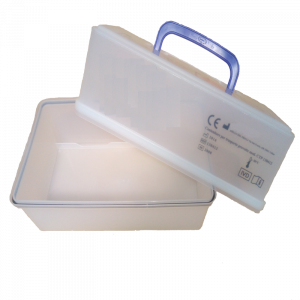TRANSPORT OF BIOPTIC CONTAINERS WITH FORMALIN
Pathological anatomy
Our transport systems for formalin containers of various sizes (with or without safety mechanism) designed for transport from various polyclinics / hospitals to pathological anatomies.
Our specialists will provide you with all the information to be able to correctly transport your samples in the various possible ways for the collection, storage and transport of biopsy samples.

Secondary container code 4530412
The rectangular polypropylene container, specific for the transport of biopsy containers with formalin (safety or otherwise), is watertight and comes with a sheet of bibulous paper for the absorption of formalin in case of spillage (each sheet absorbs 750ml) .
The transparent base makes it easier for the operator to see in the event of accidental spillage or breakage of the first container
The secondary container with the tertiary sector is P650 certified with 1.2m drop tests.
It is equipped with an upper handle to facilitate intra-hospital transport from polyclinics / surgical rooms.
The capacity is given by the primary containers in use in various organizations and the capacity of the containers themselves (size and ml of formalin containers).

The tertiary container for the transport of two secondary containers code 720202
Capacity: n ° 2 secondary containers cod. 4530412
Equipped with handles / shoulder strap for easier transport.
Equipped with two internal pockets for housing the refrigeration plate.
Externally equipped with a transparent pocket for the insertion of transport documents or hospital indications.
Each bag has a barcode with a unique number that allows the unequivocal recognition of the tertiary container.

The tertiary container for the transport of four secondary containers code 720204
Capacity: n ° 4 secondary containers cod. 4530412
Equipped with handles / shoulder strap for easier transport.
Equipped with four internal pockets for housing the refrigeration plate.
Externally equipped with a transparent pocket for the insertion of transport documents or hospital indications.
Each bag has a barcode with a unique number that allows the unequivocal recognition of the tertiary container.
